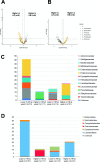The microbiota of healthy dogs demonstrates individualized responses to synbiotic supplementation in a randomized controlled trial
- PMID: 33971985
- PMCID: PMC8111948
- DOI: 10.1186/s42523-021-00098-0
The microbiota of healthy dogs demonstrates individualized responses to synbiotic supplementation in a randomized controlled trial
Abstract
Background: Probiotics have been demonstrated to ameliorate clinical signs of gastrointestinal diseases in dogs in various studies. However, the effect of probiotics in a healthy population, as well as factors contributing individualized responses, remain largely unknown. This trial examined gut microbiota (GM) and health outcomes in household dogs after synbiotic (SN) supplementation containing probiotics and inulin (a prebiotic). Healthy dogs were randomized to receive SN (50 mg/d inulin and 20 billion total CFU/d of L. reuteri, P. acidilactici, E. faecium, L. acidophilus, B. animalis, L. fermentum, L. rhamnosus) or placebo (PL) for 4 weeks. Owners completed a health survey and collected stool samples for GM profiling (shotgun metagenomic sequencing) at baseline and week 4 in both groups, and at week 6 in the SN group.
Results: A significant shift (p < 0.001) in β-diversity was observed in the SN (n = 24), but not PL group (n = 19), at week 4 relative to baseline. Forty-five bacterial species, 43 (96%) of which were Lactobacillales, showed an increase in the relative abundances (≥2 fold change, adjusted p < 0.05) in the SN group at week 4. E. coli also decreased at week 4 in the SN group (2.8-fold, adjusted p < 0.01). The altered taxa largely returned to baseline at week 6. The degree of changes in β-diversity was associated with GM at baseline. Specifically, dogs with higher Proteobacteria and lower Lactobacillales responded more robustly to supplementation in terms of the change in β-diversity. Dogs fed SN tended to have lower diarrhea incidence (0% vs 16%, p = 0.08).
Conclusions: SN supplement had a short-term impact on the gut microbiota in healthy household dogs as characterized by shotgun metagenomic sequencing. Findings warrant further investigation with longer duration and populations at risk of gastrointestinal diseases. The magnitude of response to the supplement was associated with microbial profile at baseline. To our knowledge, this is the first study documenting such association and may provide a basis for personalized nutrition in companion dogs.
Keywords: Diarrhea; Dogs; Gastrointestinal health; Inulin; Microbiome; Probiotics; Synbiotics.
Conflict of interest statement
JT, JS, RBJ, LMP, RWH are employees of and/or hold stocks or stock options in NomNomNow Inc. ARJ and HM are contracted by NomNomNow Inc. as consultants.
Figures






Similar articles
-
Heterogeneity of gut microbial responses in healthy household dogs transitioning from an extruded to a mildly cooked diet.PeerJ. 2021 Jun 30;9:e11648. doi: 10.7717/peerj.11648. eCollection 2021. PeerJ. 2021. PMID: 34249503 Free PMC article.
-
Immune status, well-being and gut microbiota in military supplemented with synbiotic ice cream and submitted to field training: a randomised clinical trial.Br J Nutr. 2021 Dec 28;126(12):1794-1808. doi: 10.1017/S0007114521000568. Epub 2021 Feb 17. Br J Nutr. 2021. PMID: 33593462 Clinical Trial.
-
Microbiota Stability and Gastrointestinal Tolerance in Response to a High-Protein Diet with and without a Prebiotic, Probiotic, and Synbiotic: A Randomized, Double-Blind, Placebo-Controlled Trial in Older Women.J Acad Nutr Diet. 2020 Apr;120(4):500-516.e10. doi: 10.1016/j.jand.2019.12.009. J Acad Nutr Diet. 2020. PMID: 32199523 Clinical Trial.
-
Prebiotic, Probiotic, and Synbiotic Supplementation in Chronic Kidney Disease: A Systematic Review and Meta-analysis.J Ren Nutr. 2019 May;29(3):209-220. doi: 10.1053/j.jrn.2018.08.008. Epub 2018 Oct 23. J Ren Nutr. 2019. PMID: 30366767
-
The effects of inulin on gut microbial composition: a systematic review of evidence from human studies.Eur J Clin Microbiol Infect Dis. 2020 Mar;39(3):403-413. doi: 10.1007/s10096-019-03721-w. Epub 2019 Nov 9. Eur J Clin Microbiol Infect Dis. 2020. PMID: 31707507
Cited by
-
Effect of an Enteroprotective Complementary Feed on Faecal Markers of Inflammation and Intestinal Microbiota Composition in Weaning Puppies.Vet Sci. 2023 Jul 3;10(7):434. doi: 10.3390/vetsci10070434. Vet Sci. 2023. PMID: 37505839 Free PMC article.
-
Heterogeneity of gut microbial responses in healthy household dogs transitioning from an extruded to a mildly cooked diet.PeerJ. 2021 Jun 30;9:e11648. doi: 10.7717/peerj.11648. eCollection 2021. PeerJ. 2021. PMID: 34249503 Free PMC article.
-
Correlation between Targeted qPCR Assays and Untargeted DNA Shotgun Metagenomic Sequencing for Assessing the Fecal Microbiota in Dogs.Animals (Basel). 2023 Aug 11;13(16):2597. doi: 10.3390/ani13162597. Animals (Basel). 2023. PMID: 37627387 Free PMC article.
-
Effect of a feed supplement containing probiotics on fecal score and clinical parameters in dogs with chronic kidney disease and intestinal disorders: A pilot study.Open Vet J. 2025 Jan;15(1):307-313. doi: 10.5455/OVJ.2025.v15.i1.29. Epub 2025 Jan 31. Open Vet J. 2025. PMID: 40092214 Free PMC article.
-
Use of Different Synbiotic Strategies to Improve Gut Health in Dogs.Animals (Basel). 2024 Nov 22;14(23):3366. doi: 10.3390/ani14233366. Animals (Basel). 2024. PMID: 39682332 Free PMC article.
References
-
- Swanson KS, Dowd SE, Suchodolski JS, Middelbos IS, Vester BM, Barry KA, Nelson KE, Torralba M, Henrissat B, Coutinho PM, Cann IKO, White BA, Fahey GC., Jr Phylogenetic and gene-centric metagenomics of the canine intestinal microbiome reveals similarities with humans and mice. ISME J. 2011;5(4):639–649. doi: 10.1038/ismej.2010.162. - DOI - PMC - PubMed
-
- Coelho LP, Kultima JR, Costea PI, Fournier C, Pan Y, Czarnecki-Maulden G, Hayward MR, Forslund SK, Schmidt TSB, Descombes P, Jackson JR, Li Q, Bork P. Similarity of the dog and human gut microbiomes in gene content and response to diet. Microbiome. 2018;6(1):72. doi: 10.1186/s40168-018-0450-3. - DOI - PMC - PubMed
LinkOut - more resources
Full Text Sources
Other Literature Sources
